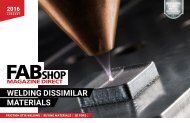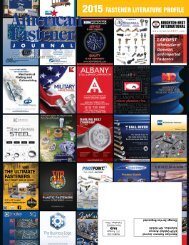100% Positive Material Identification
23mhiW2
23mhiW2
You also want an ePaper? Increase the reach of your titles
YUMPU automatically turns print PDFs into web optimized ePapers that Google loves.
Porous Titanium for Dental Implant Applications (continued)<br />
phosphate and hydroxyapatite has been<br />
used to coat dental implants. Sand<br />
blasting with stiff particles such as<br />
alumina, TiO2 and ceramic has also<br />
been suggested to roughen the dental<br />
implant surface. Çelen & Özden in 2012<br />
advocated another more controllable<br />
technique of laser micro-machining<br />
of commercially pure titanium dental<br />
implant. <strong>Material</strong>s with nanometerscale<br />
porosity such as TiO2 nanotubes<br />
have also been used recently as implant<br />
surface-treatments. These materials can<br />
be generated on the titanium dental<br />
implant by controlling the anodizing<br />
process (Figure 1).<br />
Despite being very successful, there<br />
are some shortcomings associated with<br />
these procedures; the bulk structure is<br />
still high-density titanium, the coating<br />
materials can dissolve over a long period<br />
of time. Moreover, coating particles<br />
that break away from the surface could<br />
have a negative biological effect on the<br />
adjacent tissue such as peri-implantitis.<br />
Therefore, several alternative approaches<br />
have been proposed to overcome<br />
these drawbacks of coating materials<br />
by creating porous biomaterials as a<br />
substitute for the classical solid structure.<br />
Cellular structures can provide a suitable<br />
biological environment for the host<br />
tissue to grow into the pores, providing<br />
improved early implant stability, as<br />
demonstrated by commercially available<br />
dental implants from Zimmer with<br />
a porous tantalum central region. To<br />
our knowledge, the Zimmer implant<br />
is the only porous dental implant on<br />
the market and animal and shortterm<br />
clinical studies indicate excellent<br />
bone integration and implant stability.<br />
However, tantalum is an expensive<br />
material which may not be affordable to<br />
many seeking dental implant treatments,<br />
and, therefore, methods of providing<br />
a porous structure in titanium or a<br />
titanium alloy is of strong interest to the<br />
dental implant community.<br />
To date, numerous studies have<br />
been undertaken to manipulate the<br />
mechanical and topographical properties<br />
of titanium implants. In many studies,<br />
Figure 1. SEM images of different diameter sizes of TiO2 nanotubes, (a) 30; (b) 50; (c) 70 and (d) 100 nm using<br />
200 nm scale bar.<br />
micro- and nanoporous titanium has<br />
been proposed as a promising alternative<br />
to solid structures for biomedical and<br />
dental implant applications. Many<br />
fabrication methods have been used to<br />
fabricate porous titanium for medical<br />
purposes. However, the size, shape,<br />
percentage and distribution of pores were<br />
variable and need further optimization.<br />
This review article aims to summarize<br />
the evidence in the literature of the<br />
benefits of using porous structures to<br />
improve integration of titanium dental<br />
implants with bone tissue. Furthermore,<br />
the most widely used fabrication methods<br />
for porous titanium are discussed as well<br />
as their potential to be used for dental<br />
implants.<br />
Titanium and Its Alloys as Implant<br />
<strong>Material</strong>s<br />
Ever since the 1960s, commercially<br />
pure titanium and its alloys have been<br />
shown to be versatile biomaterials that<br />
can be used to produce a variety of<br />
medical devices including those used<br />
in dentistry. This is mostly related to<br />
their unique properties such as excellent<br />
mechanical behavior, superior corrosion,<br />
as well as high ratio of strength to weight.<br />
Titanium is biocompatible because it<br />
is biologically nearly inert and well<br />
tolerated by the environment of the<br />
human body. According to the British<br />
Standards for surgical implants, the<br />
oxygen percentage should not exceed<br />
0.5%. Furthermore, the properties of<br />
titanium are influenced by its structure<br />
which is made up of two allotropic<br />
structures: a close packed hexagonal (α<br />
phase) and body-centered cubic crystal<br />
(β phase). These phases enable titanium<br />
to undergo a reversible transformation;<br />
at room temperature it tends to be<br />
categorized as α phase and transfer to β<br />
phase as the temperature exceeds 883 °C.<br />
The strength properties of<br />
commercially pure titanium are weaker<br />
than that required for medical implants.<br />
Thus, to improve these properties,<br />
titanium alloys have been proposed<br />
via incorporation of variable types and<br />
quantities of elements such as Al, Mo,<br />
V, Nb, Ta, Mn, Fe, Cr, Co, Ni and Cu.<br />
TITANIUMTODAY 53







